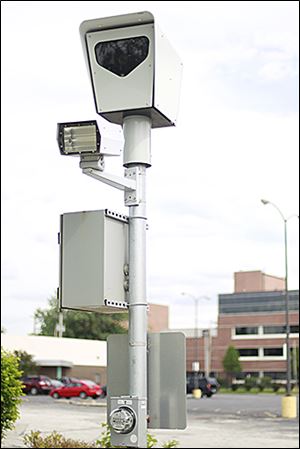
FEATURED EDITORIAL
Keep traffic cameras
Ohio’s misguided ban on speeding and red-light traffic cameras should be overturned
2/23/2015
A traffic camera at Cherry Street and East Delaware Avenue in Toledo.
Toledo officials announced last week that the city will file a lawsuit against the state of Ohio for its ban on traffic cameras set to take effect next month. The law would force Toledo to take down 44 traffic cameras that have proven to be valuable law enforcement tools. The court should strike down the state’s over-reaching law.
Click here to read more Blade editorials
In last year’s lame-duck session, Gov. John Kasich signed into law a ban on the use of traffic cameras to enforce speeding and red-light violations, unless a police officer is present. The law was opposed by then-Toledo Mayor D. Michael Collins, who asked the governor not to sign it, and other city leaders throughout the state. The cameras have drawn fierce criticism from many Ohioans and state lawmakers, who say that they’re abused by local law enforcement and used as revenue-raising tools.
That may be true in some communities, but not in Toledo, where the cameras have been used responsibly to enforce traffic laws in high-risk areas. According to the Toledo Police Department, a test conducted on a section of Anthony Wayne Trail showed 2,000 speed violations in a 12-hour period, but the number of speeding tickets issued that year for violations detected by the cameras was far below that rate. That suggests that the cameras are working, and that the city is exercising restraint in issuing tickets.
City Law Director Adam Loukx said the city questions the law’s constitutionality. He’s right: Ohio’s Constitution respects the authority of cities to decide how to govern themselves. If Ohio’s home-rule clause means anything, surely it should include the ability to decide how to enforce routine traffic violations. Lawmakers should not be allowed to force their constituents’ preferences on the entire state.
Used appropriately, the cameras aren’t intrinsically predatory any more than police officers are, and they can serve as cost-effective substitutes when a police officer is not available. But critics are right that law enforcement needs to use the tools at its disposal cautiously. Toledo, which raises millions of dollars from camera citations each year, must be particularly careful not to become dependent on the cameras for revenue.
Speeding tickets can cost as much as $100 — a significant price tag for most Toledoans. If the use of traffic cameras is upheld, city officials should consider reducing the per-ticket cost. The city’s spike in revenue from camera citations should enable them to do so.
Traffic cameras make all Toledo drivers safer and more likely to follow the law. Of course, a police officer’s judgment is superior to technology, but many Ohio communities — including this one — don’t have the resources to expand police staff. Unless state lawmakers plan to give back the funding they cut from local governments’ budgets during Governor Kasich’s term, they have no business legislating cities’ law enforcement tools.